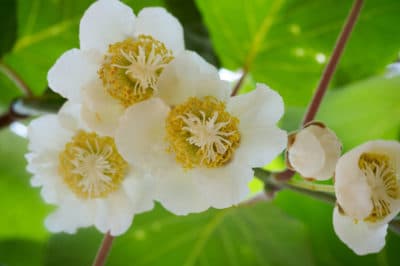Male vs. Female
Unlike some plants that bear both male and female flowers, kiwifruit are male or female, with only one kind of flower on the vine. A few kiwifruit varieties are self-fruitful, but most require a pollinator. Male and female plants have different names and are considered different varieties. The flowers of each appear different and are recognizable by their appearance.
Choosing Varieties
Although a few kiwifruits like Issai and Blake are self-fruitful, most require a pollinator. Hardy and regular kiwifruit – Actinidia deliciosa and Actinidia arguta – will often cross-pollinate. Here are some possible varieties:
- Hardy females – Anna or Ananasnaya, Dumbarton Oaks, Geneva, MSU.
- Hardy males – Meader, 74-46, 74-32.
- Regular females – Abbot, Bruno, Hayward, Monty, Vincent.
- Regular males – Mateua, Tomori, Chico.
Identification of Female Plants
You cannot determine the sex of a kiwifruit for certain until the plant actually blooms. Female flowers are white, yellow or pale cream. The flower has multiple petals with slightly ruffled edges. The center of the flower has a ring of yellowish anthers on the outside that do not produce pollen. The center of the flower also contains an ovary with white, sticky stigmas in the center.
Identifying Male Plants
Although male plants are similar in color and overall appearance, they may have fewer petals than female flowers. A male plant does not have an ovary or stigmas. Instead it has a thick cluster of stamens, usually brownish or yellow in color; a few are black. In the spring, these produce quantities of pollen which is spread by insects.
Differences in Vines
Female kiwi put much of their energy into developing fruit. For that reason, a male kiwifruit may look thicker and more vigorous than a female planted at the same time. Male vines typically produce more flowers per vine, but individual flowers are larger on a female vine. One male kiwifruit vine can pollinate up to eight female vines. Both require heavy annual pruning.
Growing Kiwifruit
Whether the vine is male or female, it needs the same care. Kiwifruit prefer slightly acidic soil but will usually grow in any soil that is well-drained. The vines can grow 40 feet in length and need copious amounts of water during the growing season. At a minimum, fertilize when plants first start to develop buds and again just before fruit set. Grow in full sun on a sturdy trellis.
